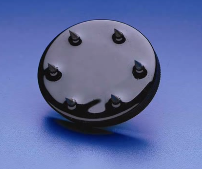For farmers who produce hay, getting accurate, reliable moisture readings in a timely manner is incredibly important.
When hay has too much moisture, it can spoil in the field, or even spontaneously combust in the silo. On the other hand, when hay has too little moisture, it loses its nutritive value and becomes a low-quality feed for grazing animals.
To get fast, accurate readings for the moisture content of hay both in the field and in the bale, farmers use special hay moisture meters. These specialized agricultural moisture meters use a variety of electrodes to read the moisture content of hay.
Different hay testing electrodes are useful for different situations. With this in mind, what are the best hay moisture meter electrodes to use for baled hay, and which ones are best for loose hay in the windrow?
To help you choose the right electrode for the job, here is a short list of some of Delmhorst’s moisture meter electrodes for hay, and whether they’re better for testing in the windrow or in your bales.
The 1235 10” Prod
 This hay moisture probe is 10" long and is designed to attach directly to the top of a Delmhorst moisture meter using the universal connector. the #1235 probe is most commonly used for testing standard hay bales.
This hay moisture probe is 10" long and is designed to attach directly to the top of a Delmhorst moisture meter using the universal connector. the #1235 probe is most commonly used for testing standard hay bales.
The long, narrow rod allows the probe to be pushed deep into a hay bale so that readings can be taken closer to the center of the bale.
This probe is generally not used for testing in the windrow, as the hay there is too loosely packed for the relatively narrow tip of the probe to get a good reading.
An 18” version of this same probe is used for larger hay bales.
The 830 Series Probe
Similar in design to the 1235 probe, the 830 series of probes comes in various lengths to get deep inside of a hay bale to test moisture near the center. This probe comes in 10”, 18”, and 36” long varieties for checking moisture in hay bales of different sizes. Each of the 830 series prods must be connected to the H-4 handle, which is then attached to the moisture meter.
The 1986 Bale Sensor
Rather than testing hay that is already baled, or still in the windrow, this sensor is designed to check the moisture content of hay as it is being baled.
Specifically designed to work with Delmhorst’s FX-2000 hay moisture tester, this sensor allows farmers to make sure that the hay that they’re baling is still within an acceptable moisture range without having to stop baling efforts.
The 831 Short Pin Prod with H-4 Handle
 Where the 1235 prod was a long, thin prod with a narrow sensor at the end, the 831 short pin prod is shaped more like a disc with six separate pins protruding from the end. This gives the 831 prod six different points to check the moisture content of a sample of hay, making it ideal for checking the moisture levels of your hay in the windrow.
Where the 1235 prod was a long, thin prod with a narrow sensor at the end, the 831 short pin prod is shaped more like a disc with six separate pins protruding from the end. This gives the 831 prod six different points to check the moisture content of a sample of hay, making it ideal for checking the moisture levels of your hay in the windrow.
Having six points of contact allow the meter to better average the moisture reading of a loosely-packed sample of hay. However, the disc shape makes this probe very poorly suited for trying to penetrate into a densely packed hay bale, so it is not used for checking moisture in baled hay.
General Advice for Selecting a Hay Moisture Probe
When you’re trying to choose a moisture probe for hay, check the design of the probe against the way the hay being tested is packed.
As a general rule of thumb, shorter probes with multiple points of contact are better for checking loosely-packed hay, such as what you get in the windrow after cutting but before baling. The extra points of contact help get a better estimate of moisture in loose hay.
On the other hand, long, narrow probes are best for testing moisture in densely-packed hay bales. These probes will experience less resistance in penetrating to the center of the hay bale, where you need to check for moisture the most.
With hay probes, you’ll have to take multiple readings and average the results to get the most accurate assessment of your hay’s moisture content.
Learn more about making high-quality hay using the free eBook at the link below:

Comments